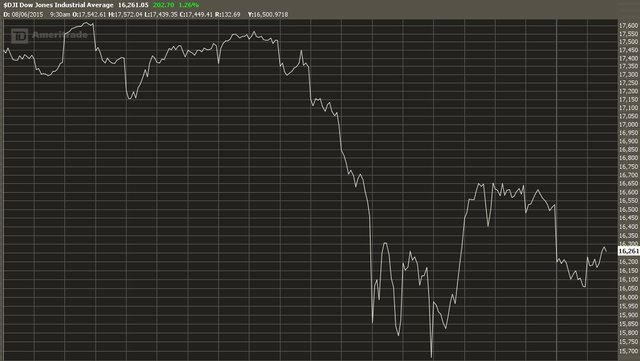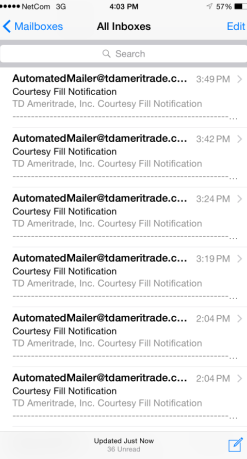4 Ways To Reduce Worry In Today's Volatile Market
A few months ago, I wrote a post entitled “What Me, Worry?”. Given the increased volatility in the past 10 days, I thought it appropriate to re-address the issue and give you some insight on approaches you can consider to reduce your financial worry.

Market volatility has certainly increased. Following is a picture of Dow Jones over the past 20 days, with a 2,000 point move from the high of 17,600 to a low of 15,600. That 2,000 point movement represents a larger swing than the Dow has experienced over the course of entire years in the past (screen print taken from my TD Ameritrade online account):

On Monday, August 24th, as I was hiking UP a 2,000 foot fjord wall with my wife on a Norwegian vacation, the market opened with a precipitous 1,000+ point movement DOWN (I should have found a hike DOWN had I known my action would have an inverse reaction in the market!). You can see the sharp decline in the middle of the graph above.
Blissfully unaware, I enjoyed the Norwegian sights.
I knew something was up, however, when I returned to town following the hike and my cell phone picked up it’s first cell tower after several hours “in the dark”. Quickly glancing at my emails, I was shocked to see a full screen of buy confirmations from my online account:

So, what triggered the rash of buying activity, and what does it have to do with how I view and manage market volatility?
Four Main Points To Manage Volatility
- Have A Plan
As part of your investment strategy, you should have a midterm and long-term plans. Realize volatility will come and go, and pre-determined how you will react when it arrives. Don’t react emotionally, just follow your plan. For example, if you plan targets a certain asset allocation, use market swings to realign your portfolio if required. If you’re already in retirement, your plan should include 1-2 years worth of living expenses to be maintained in liquid accounts (e.g., Money Market Funds) at all times. This plan would help you to avoid having to sell equities in the midst of a downturn, since you know you have several years before you need to access any money tied up in equities.
In my plan, I also have different types of accounts. For example, the majority of my portfolio is tied up in long term “buy and hold” low cost mutual funds (my 401(k) retirement plan). I may make some slight asset allocations in these accounts, but the majority is buy and hold. However, I also have a “Have Fun” account which comprises ~ 5% of my portfolio. This is where I play, and experiment around with unique trades and higher frequency market timing moves. In theory, I could lose the entire amount and be ok (if not depressed). Breaking my accounts out like this gives me the feeling of being able to react (in my “Have Fun” account) without feeling pressured to make irrational moves in my longer term retirement accounts.
- Predefine Your Actions
In the case of my email barrage, it was generated by “Good Til Cancelled” (GTC) orders I had placed months earlier in my “Have Fun” account. I had developed a list of target companies that I wanted to own at some point, but wasn’t willing to pay the current market price. I then entered “Good Til Cancelled” orders to buy these accounts if the price dropped to a certain predetermined point. (For example, if you like JNJ as a long term dividend strategy, but don’t like their price when it’s trading at $100/share, enter a GTC order to buy if the price ever hits $90, or whatever your acceptable price is. If JNJ drops to $90 at any point, your order will be filled, and you’ll be happy since you bought it at a price you had previously determined was acceptable to you (at a time of calm analysis, rather than in a rash of panic induced emotion).
Another pre-defined action recommended by the “experts” is to have pre-defined exit points (e.g., if you own JNJ and it drops by 5%, you’ll sell). This avoids getting caught up in the downturn, but I’ve found it’s harder to execute on a diverse portfolio of mutual funds, retirement accounts, etc. I have had situations where I’m entering “trailing stop loss” orders for individual stocks and ETF’s. For example, a GTC order could be placed to “sell if this stock drops by 5%”. These trailing stop prices move higher as your stock moves higher, remaining 5% below the highest price achieved. If the price drops to your target, the stock is automatically sold. There are also tools available that will monitor your various accounts, and notify you if they’ve reached a pre-determined trigger point.
- Buy When Others Are Selling, and Sell When They Are Buying
Easily said, very hard to do. I recall during the ’08-’09 collapse when I mentioned to a coworker on the elevator that I felt the market had corrected sufficiently to begin moving some of my cash assets back into the market. He was nervous, had a negative outlook on the market, and disagreed with my view. Turns out I was right, and the result of my move back into the market at extreme lows resulted in nice returns as the market recovered over the past 6 years. As part of my plan, I intentionally buy when the market dips, and sell when I feel the market is over-heated. I move in small increments, over many months, to avoid making big mistakes in my timing. It really falls under the “reallocation” strategy, as your equity portion of your portfolio will naturally get over-weighted after a period of a long bull market (and, under-weighted when the market falls). This was the case with me, as I’d been selling portions of my account (both longer term retirement and “Have Fun” accounts) over the past 6-9 months, and have been carrying an abnormally high allocation of cash as a result.
It’s very possible that the “buys” I made last week will turn out to be bad trades. If the market continues to drop, I could have bought more cheaply at a future date. That’s ok, it’s part of the plan. The same thing happens on the way up (if I would have waited before I sold, I could have made more money). That’s ok, and that’s why I only move small %’s in and out of the market at any given point in time. If it continues to drop, I’ll continue to shift more cash into stocks, gradually.
- Realize You’ll Never Get It Right
Hindsight is always 20/20, and you’ll never get it right. Had I known for a fact exactly when this correction was coming, I would have sold more when the Dow was at 18,000. Recognize that fact, and accept it. That’s where diversification comes in, and why it works. By having a broad collection of asset types in your account (see Where Should I Put My Money), you will always have some sectors that perform well and others that perform poorly. You can drive yourself crazy getting worried about “What If’s”, but there are better things to spend your time thinking about.
Over time, a well thought out, age appropriate plan should provide acceptable long term returns. Don’t try to time the market on short term moves. The key is to spend time developing a plan before panic hits, then avoid emotional reaction to short term market volatility and follow your pre-determined plan. There are many articles on this topic, and I encourage you to read up on it. Click the link to have a look at a good one that came out today from Vanguard.
As I said in Point #10 of the “What Me, Worry?” article, the key is to control what you can control, and don’t worry about the things you can’t.
With the current market environment, it’s a lesson I have to continually learn. I suspect the same is true for you.
Hopefully, this post have given you food for thought on how you can better approach the current market volatility, while still sleeping well at night. If you have any further suggestions that may benefit the readers, I encourage you to leave comments on this post.
"Hindsight is always 20/20, and you’ll never get it right."
The sobering reality of being a trader! ;-)
Stolen post do not upvote! Original is http://richtopia.com/smart-investing/4-ways-reduce-worry-todays-volatile-market
i just sharing,whats wrong?
Great post, lots learned. (◑‿◐)
thanks..
Upvoted
thanks .. may be useful
Awesome post!